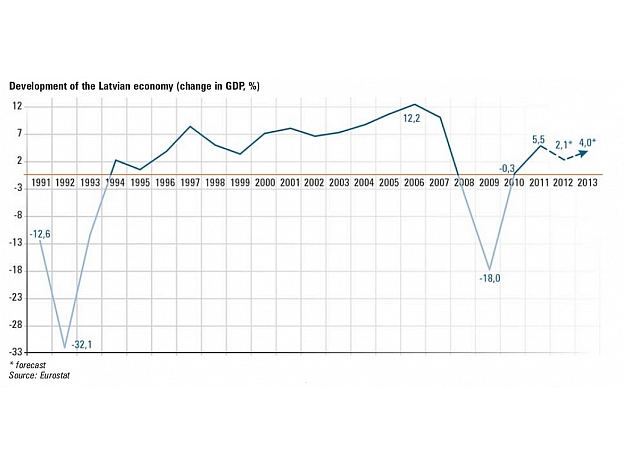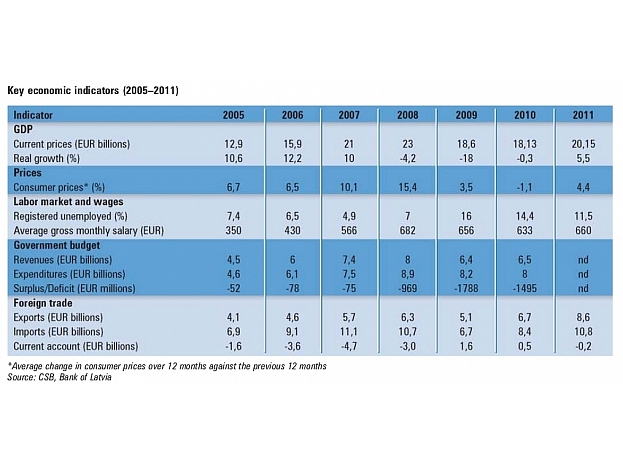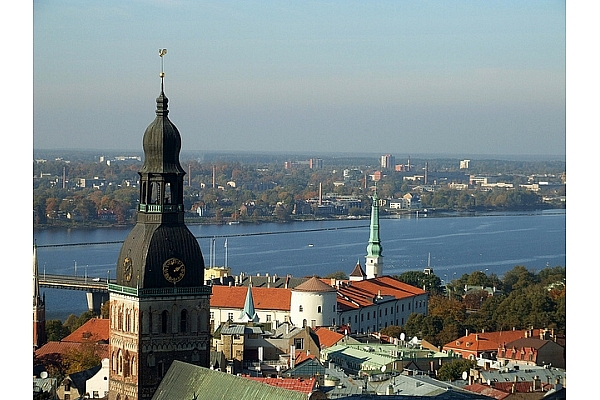Economy of Latvia
Forecasts for key indicators in 2012
GDP growth: 2,1%
Unemploymet 10,1%
Inflation: 2,4%
Latvia is again among the growth leaders in Europe
It took a little less than five years for Latvia to move from being the fastest growing economy in the EU to the fastest shrinking and then back to fastest growth again. This time the drivers of growth are different.
The past years have been stormy for the Latvian economy. From 2004 until the first half of 2008, it was the fastest growing economy in the European Union, reaching a GDP growth rate of 12,2% in 2006. During this time, the main driver of growth was a significant growth in investments and private consumption, mainly based on considerable inflows of foreign capital. In 2008 and 2009, as a result of the global financial crisis, which stopped the inflow of foreign capital, Latvia went into recession. During the crisis, GDP shrank by one quarter.
In 2009, Latvia suffered the sharest economic decline among the EU countries – by 18%. In order to be able to nationalizes the troubled Parex bank and to stabilize the financial sector, Latvian received loans amounting to EUR 7,5 billion from the European Commission (EC), the International Monetary Fund (IMF), the World Bank, the European Bank for Reconstruction and Development and several EU member states. Latvia exited the IMF/EC program at the end of 2011. During the program, much work was done in the public and private sectors to remedy internal and external imbalances. The lenders were, however, concerned about the government’s decision in October, 2011, to rescue the lossmaking airline airBaltic at a cost equal to 0,4% of GDP and by the collapse of Latvijas krājbanka, the 11th largest bank in the country, which highlighted the need for better financial oversight.
On the path of growth
The crisis has structurally changed the Latvian economy, putting it more in balance and shifting from domestic consumption to exports. After a sharp fall, Latvia has now returned to the path of growth for some time. The growth of Latvia’s economy in 2011 was much stronger than earlier estimates, making it one of the most dynamically growing economies among the EU countries. According to fourth quarter 2011 statistics Latvia took first place in the EU in terms of economic growth, outpacing its Baltic neighbors. If the average GDP growth for 27 EU countries was 1,5%, Latvia’s GDP grew by 5,5% compared to 2010, according to the Central Statistical Bureau.GDP at current prices reached EUR 20,15 billion. GDP per capita in 2011 was EUR 9764. Almost all sectors of the economy contributed to the positive growth, and declines were noted only in real estate and financial services. The greatest surprise of the year was construction, which grew 12,3% y-o-y. The greatest growth – 21,8% – was posted by accommodation and food services, which is closely tied to tourism. The three largest sectors of the economy – trade, manufacturing and transport – contributed the most to economic growth in 2011: 8,7%, 11% and 8% respectively. These together boosted GDP by four percentage points. Investments also grew rapidly in 2011 and are a prerequisite for further economic growth. There were positive changes, too, in the structure of investment, with rapid growth of investments in productive sectors. The export of goods and services retained its roll as the main driver of the economy in 2011 as well. Despite the negative developments in the global economy, especially in Europe, Latvia’s exports showed very fast growth.
Economic development
*Positive growth is forecast for the Latvian economy in 2012, although GDP growth will be lower than in 2011. The positive data about economic development in Latvia leads one to be cautious, because economic activity in the EU as a whole is low and a recession is forecast for the eurozone. The Latvian Ministry of Finance has reduced its 2012 GDP growth forecast to 2% from 2,5%.
*There could be both positive and negative effects on the Latvian economy from Russia’s plans to join the WTO. Latvian enterprises will gain from the lifting of Russian tariff restrictions on raw materials, from lower tariffs and diminished non-tariff barriers. Russia will also lower its import tariffs on a wide range of goods. Russia’s joining the WTO could possibly threaten the export of some Latvian products (for example, pulpwood).
*Concern about economic growth arises from the tensions between the EU and Belarus. Enforcement EU economic sanctions against Belarus, according to 2011 figures, the Latvian economy could suffer losses of 3% of GDP and 8,1% of state budget revenues, it would freeze investments amounting to around EUR 6 million.
*Latvia has a good outlook for joining the eurozone in 2014, because Latvia is on its way to fulfilling the Maastricht criteria.
Priority sectors
*The most important part of Latvia’s GDP, around 70%, is comprised by the services sector. The share of the manufacturing industries is 14,1% of GDP, trade – 16%, transport and logistics – 13%, construction – 6,1%.
* Political leaders defined the development of manufacturing companies and increase in export volumes as a basis for economic recovery. However, Latvia is characterized by frequent changes in its government, thus the implementation of such medium-term plans is not always possible.
* The priority sectors have been defined as: food and beverage production, production of wood products, production of pharmaceuticals, chemicals and chemical products, production of metals and metal products, production of computers, electronic and optical equipment, telecommunications, software development and ancillary services for transport and logistics. From 2011, companies investing at least LVL 3 million (EUR 4,3 million) will get a reduction in corporate income tax of 25% of the amount invested. For investments over LVL 35 million (EUR 49,8 million), a tax reduction of 15% is applied.
*Investments are attracted in Latvia also by other methods. For example, investors can obtain a permit for residence in Latvia – moreover, in all the EU, if they acquire real estate of the value EUR 142 000 in Riga or EUR 71 000 in other areas in Latvia, or invest EUR 285 000 into the subordinated capital of a Latvian bank, or also invest EUR 36 000 into a company’s authorized capital.
*The tourism development is purposefully promoted by the government, investing funds into the marketing campaigns, and developing the infrastructure projects, for example the International Airport of Riga. The tourism industry companies also apply a reduced value-added tax rate – 12% instead of a standard rate 22%.
*Financial state support to companies is mostly accessible from the EU funds. Apart from the EU co-financed programs, there are not many special support programs, and they are basically aimed at supporting micro and small companies.
*The geographical location of the state made it an important transit partner for both CIS and European states. Latvia has three large ports – in Ventspils, Riga and Liepaja. At Ventspils and Riga ports there is a free economic area, and Liepaja port is a component of a special economic area. These areas in Latvia there are offer tax relief or other benefits to companies operating there.
Forecasts for key indicators in 2012
GDP growth: 2,1%
Unemploymet 10,1%
Inflation: 2,4%
Latvia is again among the growth leaders in Europe
It took a little less than five years for Latvia to move from being the fastest growing economy in the EU to the fastest shrinking and then back to fastest growth again. This time the drivers of growth are different.
The past years have been stormy for the Latvian economy. From 2004 until the first half of 2008, it was the fastest growing economy in the European Union, reaching a GDP growth rate of 12,2% in 2006. During this time, the main driver of growth was a significant growth in investments and private consumption, mainly based on considerable inflows of foreign capital. In 2008 and 2009, as a result of the global financial crisis, which stopped the inflow of foreign capital, Latvia went into recession. During the crisis, GDP shrank by one quarter.
In 2009, Latvia suffered the sharest economic decline among the EU countries – by 18%. In order to be able to nationalizes the troubled Parex bank and to stabilize the financial sector, Latvian received loans amounting to EUR 7,5 billion from the European Commission (EC), the International Monetary Fund (IMF), the World Bank, the European Bank for Reconstruction and Development and several EU member states. Latvia exited the IMF/EC program at the end of 2011. During the program, much work was done in the public and private sectors to remedy internal and external imbalances. The lenders were, however, concerned about the government’s decision in October, 2011, to rescue the lossmaking airline airBaltic at a cost equal to 0,4% of GDP and by the collapse of Latvijas krājbanka, the 11th largest bank in the country, which highlighted the need for better financial oversight.
On the path of growth
The crisis has structurally changed the Latvian economy, putting it more in balance and shifting from domestic consumption to exports. After a sharp fall, Latvia has now returned to the path of growth for some time. The growth of Latvia’s economy in 2011 was much stronger than earlier estimates, making it one of the most dynamically growing economies among the EU countries. According to fourth quarter 2011 statistics Latvia took first place in the EU in terms of economic growth, outpacing its Baltic neighbors. If the average GDP growth for 27 EU countries was 1,5%, Latvia’s GDP grew by 5,5% compared to 2010, according to the Central Statistical Bureau.GDP at current prices reached EUR 20,15 billion. GDP per capita in 2011 was EUR 9764. Almost all sectors of the economy contributed to the positive growth, and declines were noted only in real estate and financial services. The greatest surprise of the year was construction, which grew 12,3% y-o-y. The greatest growth – 21,8% – was posted by accommodation and food services, which is closely tied to tourism. The three largest sectors of the economy – trade, manufacturing and transport – contributed the most to economic growth in 2011: 8,7%, 11% and 8% respectively. These together boosted GDP by four percentage points. Investments also grew rapidly in 2011 and are a prerequisite for further economic growth. There were positive changes, too, in the structure of investment, with rapid growth of investments in productive sectors. The export of goods and services retained its roll as the main driver of the economy in 2011 as well. Despite the negative developments in the global economy, especially in Europe, Latvia’s exports showed very fast growth.
Economic development
*Positive growth is forecast for the Latvian economy in 2012, although GDP growth will be lower than in 2011. The positive data about economic development in Latvia leads one to be cautious, because economic activity in the EU as a whole is low and a recession is forecast for the eurozone. The Latvian Ministry of Finance has reduced its 2012 GDP growth forecast to 2% from 2,5%.
*There could be both positive and negative effects on the Latvian economy from Russia’s plans to join the WTO. Latvian enterprises will gain from the lifting of Russian tariff restrictions on raw materials, from lower tariffs and diminished non-tariff barriers. Russia will also lower its import tariffs on a wide range of goods. Russia’s joining the WTO could possibly threaten the export of some Latvian products (for example, pulpwood).
*Concern about economic growth arises from the tensions between the EU and Belarus. Enforcement EU economic sanctions against Belarus, according to 2011 figures, the Latvian economy could suffer losses of 3% of GDP and 8,1% of state budget revenues, it would freeze investments amounting to around EUR 6 million.
*Latvia has a good outlook for joining the eurozone in 2014, because Latvia is on its way to fulfilling the Maastricht criteria.
Priority sectors
*The most important part of Latvia’s GDP, around 70%, is comprised by the services sector. The share of the manufacturing industries is 14,1% of GDP, trade – 16%, transport and logistics – 13%, construction – 6,1%.
* Political leaders defined the development of manufacturing companies and increase in export volumes as a basis for economic recovery. However, Latvia is characterized by frequent changes in its government, thus the implementation of such medium-term plans is not always possible.
* The priority sectors have been defined as: food and beverage production, production of wood products, production of pharmaceuticals, chemicals and chemical products, production of metals and metal products, production of computers, electronic and optical equipment, telecommunications, software development and ancillary services for transport and logistics. From 2011, companies investing at least LVL 3 million (EUR 4,3 million) will get a reduction in corporate income tax of 25% of the amount invested. For investments over LVL 35 million (EUR 49,8 million), a tax reduction of 15% is applied.
*Investments are attracted in Latvia also by other methods. For example, investors can obtain a permit for residence in Latvia – moreover, in all the EU, if they acquire real estate of the value EUR 142 000 in Riga or EUR 71 000 in other areas in Latvia, or invest EUR 285 000 into the subordinated capital of a Latvian bank, or also invest EUR 36 000 into a company’s authorized capital.
*The tourism development is purposefully promoted by the government, investing funds into the marketing campaigns, and developing the infrastructure projects, for example the International Airport of Riga. The tourism industry companies also apply a reduced value-added tax rate – 12% instead of a standard rate 22%.
*Financial state support to companies is mostly accessible from the EU funds. Apart from the EU co-financed programs, there are not many special support programs, and they are basically aimed at supporting micro and small companies.
*The geographical location of the state made it an important transit partner for both CIS and European states. Latvia has three large ports – in Ventspils, Riga and Liepaja. At Ventspils and Riga ports there is a free economic area, and Liepaja port is a component of a special economic area. These areas in Latvia there are offer tax relief or other benefits to companies operating there.

Autors: latvijas_ekonomika_en_8_1_3_1036x518

Autors: latvijas_ekonomika_en_9_1_en_1_1015x496
Risks
*Latvia’s economic development in the future will be closely tide to export opportunities; therefore the greatest risk to Latvia’s growth is linked to development in the global economy. As growth rates slow for its main trading partners, the growth of Latvia’s exports will moderate and slow down Latvia’s economic development.
*Latvia is characterized by ra
Ther high energy dependency on Russia, which the Baltic countries, acting together, hope to diminish by developing a common nuclear power plant. Latvia has started work on its "Energy Strategy 2030" which is aimed at cost competiti¬veness, sustainability of the sector and security and stability of supply. Latvia has set a goal of having a 40% share of renewable energy in its energy supply by 2020. This goal is seen as reachable, because currently renewable resources made up around a third of the nation’s sources of energy. The main source is the hydroelectric power plants along Latvia’s largest river, the Daugava.
Useful links
Bank of Latvia – www.bank.lv
Central Statistical Bureau of Latvia – www.csb.gov.lv
Ministry of Economics of the Republic of Latvia – www.em.gov.lv
Ministry of Finance of the Republic of Latvia – www.fm.gov.lv
Ministry of Foreign Affairs of the Republic of Latvia – www.am.gov.lv
Investment and Development Agency of Latvia – www.liaa.lv
Stock Exchange – www.nasdaqomxbaltic.com
Foreign Investors Council in Latvia – www.ficil.lv
Employers’ Confederation of Latvia – www.lddk.lv
Portal of the State of Latvia – www.latvija.lv
Photo: Stock.XCHNG





